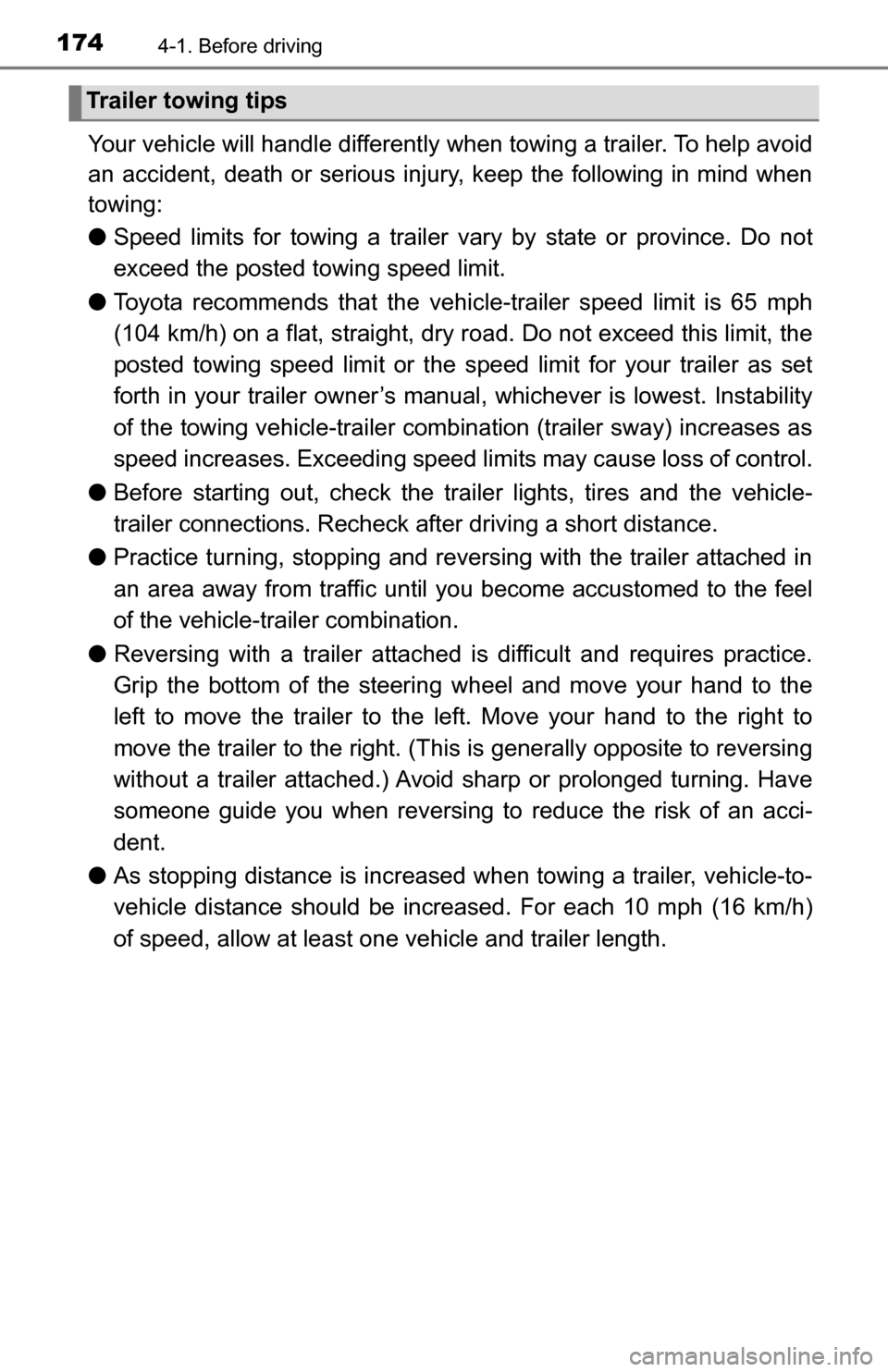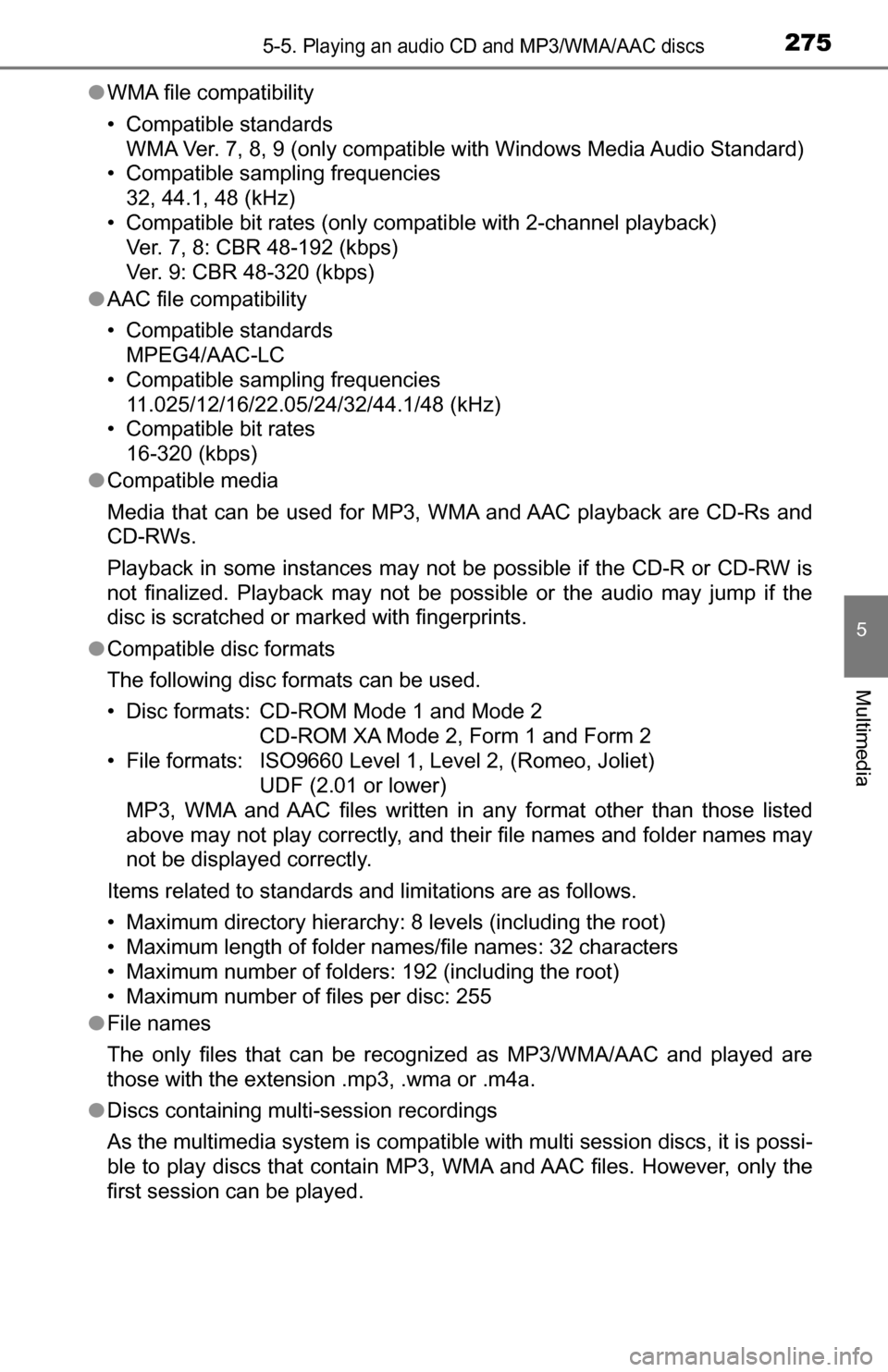Page 111 of 588
1113-3. Adjusting the seats
3
Operation of each component
Front seats
■Driver’s seat
■Passenger’s seat
Manual seat
Adjustment procedure (separated type seats)
Seat position adjustment
switch
Seatback angle adjustment
switch
Seat cushion length adjust-
ment switch (if equipped)Seat cushion (front) angle
adjustment switch
Seat vertical height adjust-
ment switch
Seat lumbar support adjust-
ment switch1
2
3
4
5
6
Seat position adjust
ment lever Seatback angle adjustment
lever12
Page 172 of 588
1724-1. Before driving
The rear bumper of your vehicle is
equipped with a hole to install a
trailer ball. If you have any ques-
tions, contact your Toyota dealer.
The gross trailer weight (trailer
weight plus cargo weight) when
towing with the bumper must never
exceed the TWR (P. 162) or
5000 lb. (2268 kg) whichever is
lower.
Use the correct trailer ball for your application.
Trailer ball load rating
Matches or exceeds the gross
trailer weight rating of the trailer.
Ball diameter
Matches the size of the trailer cou-
pler. Most couplers are stamped
with the required trailer ball size.
Shank length
Protrudes beyond the bottom of the lock washer and nut by at least 2
threads.
Shank diameter
Matches the ball mount hole diameter size.
Bumper towing (vehicles with steel bumper only)
Selecting trailer ball
1
2
Trailer classIVII and IIII
Typical trailer ball size2 5/16 in.2 in.1 7/8 in.
3
4
Page 174 of 588

1744-1. Before driving
Your vehicle will handle differently when towing a trailer. To help avoid
an accident, death or serious injury, keep the following in mind when
towing:
● Speed limits for towing a trailer vary by state or province. Do not
exceed the posted to wing speed limit.
● Toyota recommends that the vehi cle-trailer speed limit is 65 mph
(104 km/h) on a flat, straight, dry road. Do not exceed this limit, the
posted towing speed limit or the spe ed limit for your trailer as set
forth in your trailer owner’s manual, whichever is lowest. Instability
of the towing vehicle-trailer combination (trailer sway) increases as
speed increases. Exceeding speed limits may cause loss of control.
● Before starting out, check the tr ailer lights, tires and the vehicle-
trailer connections. Recheck after driving a short distance.
● Practice turning, stopping and reversing with the trailer attached in
an area away from traffic until you become accustomed to the feel
of the vehicle-trailer combination.
● Reversing with a trailer attached is difficult and requires practice.
Grip the bottom of the steering wheel and move your hand to the
left to move the trailer to the left . Move your hand to the right to
move the trailer to the right. (This is generally opposite to reversing
without a trailer attached.) Avoid sharp or prolonged turning. Have
someone guide you when reversing to reduce the risk of an acci-
dent.
● As stopping distance is increased when towing a trailer, vehicle-to-
vehicle distance should be increased. For each 10 mph (16 km/h)
of speed, allow at least one vehicle and trailer length.
Trailer towing tips
Page 175 of 588

1754-1. Before driving
4
Driving
●Avoid sudden braking as you may skid, resulting in the trailer jack-
knifing and a loss of vehicle control. This is especially true on wet or
slippery surfaces.
● Avoid jerky starts or sudden acceleration.
● Avoid jerky steering and sharp turns, and slow down before making
a turn.
● Note that when making a turn, the trailer wheels will be closer than
the vehicle wheels to the inside of the turn. Compensate by making
a wider than normal turning radius.
● Slow down before making a turn, in crosswinds, on wet or slippery
surfaces, etc.
Increasing vehicle speed c an destabilize the trailer.
● Take care when passing other vehicles. Passing requires consider-
able distance. After passing a vehi cle, do not forget the length of
your trailer, and be sure you hav e plenty of room before changing
lanes.
● To maintain engine braking efficiency and charging system perfor-
mance when using engine braking, do not use the transmission in
D.
Transmission shift range positi on must be in 4 in the S mode.
● Instability happens more frequently when descending steep or long
downhill grades. Before descending, slow down and downshift. Do
not make sudden downshifts while descending steep or long down-
hill grades.
● Avoid holding the brake pedal down too long or applying the brakes
too frequently. This could cause the brakes to overheat and result in
reduced braking efficiency.
● Due to the added load of the trailer, your vehicle’s engine may over-
heat on hot days (at temperatures over 85°F [30°C]) when driving
up a long or steep grade. If t he engine coolant temperature gauge
indicates overheating, immediately turn off the air conditioning (if in
use), pull your vehicle off the road and stop in a safe spot.
( P. 505)
Page 275 of 588

2755-5. Playing an audio CD and MP3/WMA/AAC discs
5
Multimedia
●WMA file compatibility
• Compatible standards
WMA Ver. 7, 8, 9 (only compatible with Windows Media Audio Standard)
• Compatible sampling frequencies 32, 44.1, 48 (kHz)
• Compatible bit rates (only compatible with 2-channel playback) Ver. 7, 8: CBR 48-192 (kbps)
Ver. 9: CBR 48-320 (kbps)
● AAC file compatibility
• Compatible standards
MPEG4/AAC-LC
• Compatible sampling frequencies
11.025/12/16/22.05/24/32/44.1/48 (kHz)
• Compatible bit rates 16-320 (kbps)
● Compatible media
Media that can be used for MP3, WMA and AAC playback are CD-Rs and
CD-RWs.
Playback in some instances may not be possible if the CD-R or CD-RW is
not finalized. Playback may not be possible or the audio may jump if the
disc is scratched or marked with fingerprints.
● Compatible disc formats
The following disc formats can be used.
• Disc formats: CD-ROM Mode 1 and Mode 2
CD-ROM XA Mode 2, Form 1 and Form 2
• File formats: ISO9660 Level 1, Level 2, (Romeo, Joliet) UDF (2.01 or lower)
MP3, WMA and AAC files written in any format other than those listed
above may not play correctly, and their file names and folder names may
not be displayed correctly.
Items related to standards and limitations are as follows.
• Maximum directory hierarchy: 8 levels (including the root)
• Maximum length of folder names/file names: 32 characters
• Maximum number of folders: 192 (including the root)
• Maximum number of files per disc: 255
● File names
The only files that can be recognized as MP3/WMA/AAC and played are
those with the extension .mp3, .wma or .m4a.
● Discs containing multi-session recordings
As the multimedia system is compatible with multi session discs, it is possi-
ble to play discs that contain MP3, WMA and AAC files. However, only the
first session can be played.
Page 510 of 588
5109-1. Specifications
Maintenance data (fuel, oil level, etc.)
2WD models
*1: Unladen vehicle
*2: P255/70R18 tires
*3: P275/65R18 tires
*4: P275/55R20 tires
Dimensions
Cab type Regular Cab Double Cab CrewMax
Bed type Long Standard Long Short
Overall
length228.9 in. (5815 mm) 247.8 in.
(6295 mm) 228.9 in.
(5815 mm)
Overall
width 79.9 in. (2030 mm)
Overall
height
*1
75.7 in.
(1925 mm)
*275.9 in.
(1930 mm)
*275.7 in.
(1925 mm)
*2
75.5 in.
(1920 mm)
*375.7 in.
(1925 mm)
*3,*475.5 in.
(1920 mm)
*3,*4
Wheelbase 145.6 in. (3700 mm) 164.5 in.
(4180 mm) 145.6 in.
(3700 mm)
Front tread 67.9 in. (1725 mm)
Rear tread 67.9 in. (1725 mm)
Page 511 of 588
5119-1. Specifications
9
Vehicle specifications
4WD models
*1: Unladen vehicle
*2: P255/70R18 tires
*3: P275/65R18 tires
*4: P275/55R20 tires
Cab type Regular Cab Double CabCrewMax
Bed type Long Standard Long Short
Overall
length228.9 in. (5815 mm) 247.8 in.
(6295 mm) 228.9 in.
(5815 mm)
Overall
width 79.9 in. (2030 mm)
Overall
height
*1
76.1 in.
(1935 mm)
*276.3 in.
(1940 mm)
*276.1 in.
(1935 mm)
*2
75.9 in.
(1930 mm)
*376.1 in.
(1935 mm)
*3,*475.9 in.
(1930 mm)
*3,*4
Wheelbase 145.6 in. (3700 mm) 164.5 in.
(4180 mm) 145.6 in.
(3700 mm)
Front tread 67.9 in. (1725 mm)
Rear tread 67.9 in. (1725 mm)